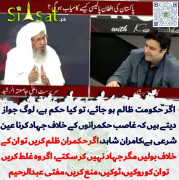hans
Banned
The Year of the Chapatis
In late 1856, rumors swept across northern India about a new rifle being used by the East India Company the Lee-Enfield Rifle. The rifles ammunition was carried in a paper-wrapped cartridge with the powder and ball. The paper was greased to be water-proof. For a single-hand load, the soldier would tear the cartridge with his teeth, pour the powder down the muzzle, put the ball in the muzzle, shove it with the ramrod, aim and fire. For demonstration, watch Barry Lyndon or go to a local Civil War Re-Enactement. Yes, the Lee-Enfield was the gun used during the Civil War.
The cartridges were produced in Fort Williams, Calcutta and supplied to the depots where instructions were handed out in their usage. One depot in Calcutta, Dum Dum [later giving its name to the bullet developed there], was the source in early 1857 of rumors that the grease used to water-proof the paper was made up of a mixture of cow and pig fat.
The Commanding officers immediately tried to spread the word that it was mutton-fat and wax, but the news was spreading out across the land that biting the cartridge wrapper would desecrate both the Brahmin Hindus and the Muslim sepoys in the East India Company army.
The British feared that this news was spreading and the sepoys were mobilizing for a revolt. But how? They suspected that villages across India were using chapatis (flat, round indian bread) to hand-delivered from village to village especially in Awadh and Bengal to organize themselves. The secret paper messages were baked inside the chapati.
In any case, the result was the Uprising of 1857.
Postcolonial authors have tried to discern the meaning behind the chapatis, as well though they remain mysterious to this day.
Amusingly these days they may be chapatis around the table but a Cell phone seems the right tool for circulation of Public opinion. Or better Web sites like Siasat.pk.
In late 1856, rumors swept across northern India about a new rifle being used by the East India Company the Lee-Enfield Rifle. The rifles ammunition was carried in a paper-wrapped cartridge with the powder and ball. The paper was greased to be water-proof. For a single-hand load, the soldier would tear the cartridge with his teeth, pour the powder down the muzzle, put the ball in the muzzle, shove it with the ramrod, aim and fire. For demonstration, watch Barry Lyndon or go to a local Civil War Re-Enactement. Yes, the Lee-Enfield was the gun used during the Civil War.
The cartridges were produced in Fort Williams, Calcutta and supplied to the depots where instructions were handed out in their usage. One depot in Calcutta, Dum Dum [later giving its name to the bullet developed there], was the source in early 1857 of rumors that the grease used to water-proof the paper was made up of a mixture of cow and pig fat.
The Commanding officers immediately tried to spread the word that it was mutton-fat and wax, but the news was spreading out across the land that biting the cartridge wrapper would desecrate both the Brahmin Hindus and the Muslim sepoys in the East India Company army.
The British feared that this news was spreading and the sepoys were mobilizing for a revolt. But how? They suspected that villages across India were using chapatis (flat, round indian bread) to hand-delivered from village to village especially in Awadh and Bengal to organize themselves. The secret paper messages were baked inside the chapati.
In any case, the result was the Uprising of 1857.
Postcolonial authors have tried to discern the meaning behind the chapatis, as well though they remain mysterious to this day.
Amusingly these days they may be chapatis around the table but a Cell phone seems the right tool for circulation of Public opinion. Or better Web sites like Siasat.pk.


























